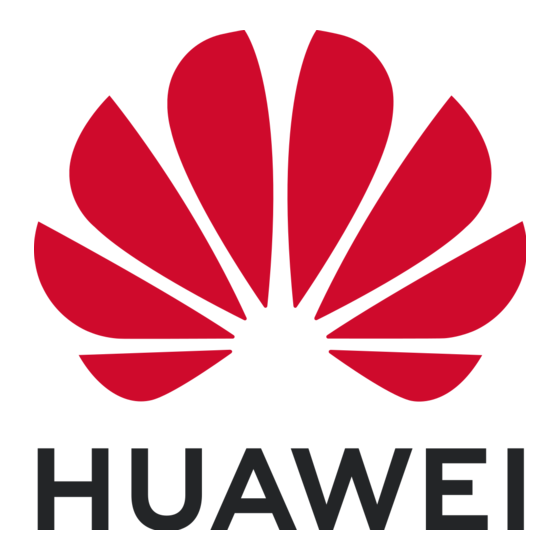
Summary of Contents for Huawei HiKey960
- Page 1 HiKey960 Development Board Hardware User Manual HiKey960 Development Board Hardware User Manual Version 1.0 1/20...
-
Page 2: Table Of Contents
HiKey960 Development Board Hardware User Manual Table of Contents Table of Contents ............................2 Introduction ..............................3 What’s in the Box ............................4 Board Overview............................5 Key Components ............................6 System Block Diagram ..........................7 Getting Started ............................8 Prerequisites ............................8 Starting the board for the first time ...................... -
Page 3: Introduction
HiKey960 Development Board Hardware User Manual Introduction The HiKey960 Development Board is a 96Boards compliant community board based on Hisilicon Kirin960 SoC. The following table lists its key features: Kirin 960 SoC Processor 4x Cortex-A73 @ 2.4GHz 4x Cortex-A53 @ 1.8GHz... -
Page 4: What's In The Box
HiKey960 Development Board Hardware User Manual What’s in the Box The box contains one HiKey960 Development Board and a quick start guide. 4/20... -
Page 5: Board Overview
HiKey960 Development Board Hardware User Manual Board Overview 5/20... -
Page 6: Key Components
HiKey960 Development Board Hardware User Manual Key Components Position Reference Description J2002 Low Speed Expansion Connector P401 DC Input 8-18V U1601 UFS 32GB U501 Kirin960 & 3GB LPDDR4 U2101 WLAN P2301 Micro SD Card Socket J2001 High Speed Connector J1901... -
Page 7: System Block Diagram
HiKey960 Development Board Hardware User Manual System Block Diagram 7/20... -
Page 8: Getting Started
To start the board, follow these simple steps: step1. Connect the HiKey960 to your display with the HDMI cable. It is important to do this first becausethe monitor will not detect the board if it is connected after starting. Ensure that the source for the displayis switched to the HDMI port you are using. -
Page 9: Component Details
Storage The Hikey960 Development Board provides an 32GB UFS which is compliant with UFS2.0. Micro SDHC The Hikey960 Development Board SD slot signals are routed directly to the Kirin960 SDC interface. It meets the SD3.0 standard. Boot ROM The Hikey960 Development Board boots up from the UFS. -
Page 10: Camera Interface
USB Ports The Hikey960 Development Board supports a USB OTG port and three USB host ports via a USB MUX. The input channel( D+/D-) of USB MUX is connected to the usb port of the SOC, and the two output channels(1D+/1D-,2D+/2D-) are connected to type C USB port and USB hub respectively. -
Page 11: Audio
HiKey960 Development Board Hardware User Manual USB OTG ports The Hikey960 Development Board implements a OTG port. The port is located at J1701, a type C USB. Note: the board can work in one mode at a time, Host mode or Device mode, not both. -
Page 12: Additional Functionality
TheHikey960 Development Board drives the four LEDs from the soc GPIO: GPIO150, GPIO151, GPIO189and GPIO190. Additional Functionality The Hikey960 Development Board also has a additional interface for user debugging. It includes JTAG interface. The position is reserved, but the component is not mounted in the mass production. 12/20... -
Page 13: Expansion Connectors
2-wire UART, UART1 on the Low Speed Expansion Connector.The HiKey960 Development Board implements UART3 as a 4-wire UART that connects directly to theMT6797 SoC. These signals are driven at 1.8V.The HiKey960 Development Board implements UART6 as a 2-wire UART that connects directly to theMT6797 SoC. These signals are driven at 1.8V. -
Page 14: High Speed Expansion Connector
Connector. The CLK, FS and DO signals are required while the DI is optional. The HiKey960 Development Board implements a I2S interface with 4 wires, CLK, FS, DO and DI. The signals are connected directly to the Kirin960 SoC and driven at 1.8V. - Page 15 A minimum of one lane is required and up to four lanes can be accommodated on the connector. The Hikey960 Development Board implementation supports a full four lane (1.2Gbps/lane) MIPI-DSI interface that is routed to the High Speed Expansion Connector. The MIPI-DSI signals are directly connected to DSI-0 of Kirin960.
- Page 16 ExpansionConnector. Both interfaces are optional. CSI0 interface can be up to four lanes while CSI1 is up to twolanes. The Hikey960 Development Board implementation supports a full four lane MIPI-CSI interface on CSI0 and two lanes of MIPI-CSI on CSI1. All MIPI-CSI signals are routed directly to/from the Kirin960 SoC.
-
Page 17: Power Management Overview
HiKey960 D Development Bo oard Hardware U User Manual verview Mana agement ock Diagra Power In An 8V to o 18V power f from a dedicat ted DC jack J9 901. An 8V to o 18V power f... -
Page 18: Voltage Rails
HiKey960 Development Board Hardware User Manual Voltage Rails Default ON Iout Max Circuit Type Net Name Expected use Voltage(V) (mA) 18/20... - Page 19 HiKey960 Development Board Hardware User Manual SYS5V 5000 system 5V VDD4V2 5000 system power VDDCPUB 16000 4Cortex A73 4Cortex A53 VDDCPUL 1.05 30000 BUCK VDDGPU 12000 Core power for GPU Vbuck00V8 2500 core power for PERI Vbuck11V1 3000 DRAM and LDO Vbuck21V45 1.45...
-
Page 20: Mechanical Specification
HiKey960 Development Board Hardware User Manual Mechanical specification The Hikey960 Development Board is compliant with the 96boards mechanical specification. FCC Regulations: This device complies with part 15 of the FCC Rules. Operation is subject to the following two conditions: (1) This device may not cause harmful interference, and (2) this device must accept any interference received, including interference that may cause undesired operation. - Page 21 HiKey960 Development Board Hardware User Manual harmful interference to radio or television reception, which can be determined by turning the equipment off and on, the user is encouraged to try to correct the interference by one or more of the following measures: —Reorient or relocate the receiving antenna.


